
William Morris was an English textile designer, poet, artist, writer, and socialist activist associated with the British Arts and Crafts movement. He was a major contributor to the revival of traditional British textile arts and methods of production. His literary contributions helped to establish the modern fantasy genre, while he helped win acceptance of socialism in fin de siècle Great Britain.
Valinor or the Blessed Realm is a fictional location in J. R. R. Tolkien's legendarium, the home of the immortal Valar on the continent of Aman, far to the west of Middle-earth; he used the name Aman mainly to mean Valinor. It includes Eldamar, the land of the Elves, who as immortals are permitted to live in Valinor.
In J. R. R. Tolkien's fictional legendarium, Beleriand was a region in northwestern Middle-earth during the First Age. Events in Beleriand are described chiefly in his work The Silmarillion, which tells the story of the early ages of Middle-earth in a style similar to the epic hero tales of Nordic literature, with a pervasive sense of doom over the character's actions. Beleriand also appears in the works The Book of Lost Tales, The Children of Húrin, and in the epic poems of The Lays of Beleriand.
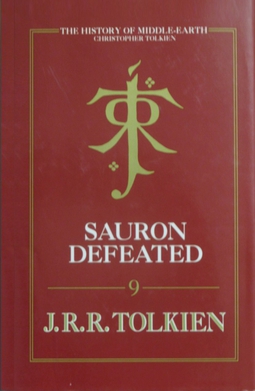
The History of Middle-earth is a 12-volume series of books published between 1983 and 1996 by George Allen & Unwin in the UK and by Houghton Mifflin in the US. They collect and analyse much of J. R. R. Tolkien's legendarium, compiled and edited by his son Christopher Tolkien. The series shows the development over time of Tolkien's conception of Middle-earth as a fictional place with its own peoples, languages, and history, from his earliest notions of "a mythology for England" through to the development of the stories that make up The Silmarillion and The Lord of the Rings. It is not a "history of Middle-earth" in the sense of being a chronicle of events in Middle-earth written from an in-universe perspective; it is instead an out-of-universe history of Tolkien's creative process. In 2000, the twelve volumes were republished in three limited edition omnibus volumes. Non-deluxe editions of the three volumes were published in 2002.

The Adventures of Tom Bombadil is a 1962 collection of poetry by J. R. R. Tolkien. The book contains 16 poems, two of which feature Tom Bombadil, a character encountered by Frodo Baggins in The Lord of the Rings. The rest of the poems are an assortment of bestiary verse and fairy tale rhyme. Three of the poems appear in The Lord of the Rings as well. The book is part of Tolkien's Middle-earth legendarium.
Narrative poetry is a form of poetry that tells a story, often using the voices of both a narrator and characters; the entire story is usually written in metered verse. Narrative poems do not need to rhyme. The poems that make up this genre may be short or long, and the story it relates to may be complex. It is normally dramatic, with various characters. Narrative poems include all epic poetry, and the various types of "lay", most ballads, and some idylls, as well as many poems not falling into a distinct type.
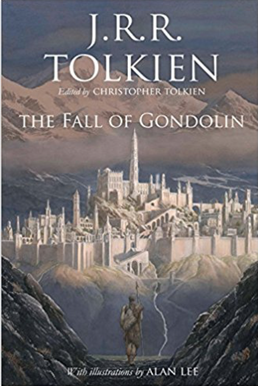
J. R. R. Tolkien's The Fall of Gondolin is a 2018 book of fantasy fiction by J. R. R. Tolkien, edited by his son Christopher. The story is one of what Tolkien called the three "Great Tales" from the First Age of Middle-earth; the other two are Beren and Lúthien and The Children of Húrin. All three stories are briefly summarised in the 1977 book The Silmarillion, and all three have now been published as stand-alone books. A version of the story also appears in The Book of Lost Tales. In the narrative, Gondolin was founded by King Turgon in the First Age. The city was carefully hidden, enduring for centuries before being betrayed and destroyed. Written in 1917, it is one of the first stories of Tolkien's legendarium.
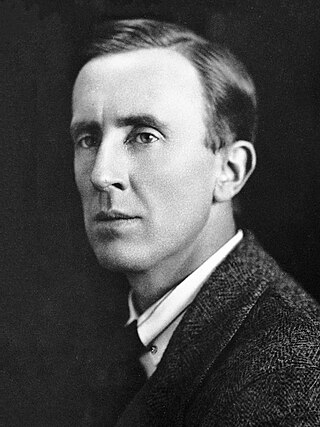
The Round World Version is an alternative creation myth to the version of J.R.R. Tolkien's legendarium as it appears in The Silmarillion and The Lord of the Rings. In that version, the Earth was created flat and was changed to round as a cataclysmic event during the Second Age in order to prevent direct access by Men to Valinor, home of the immortals. In the Round World Version, the Earth is created spherical from the beginning.

"The Man in the Moon Stayed Up Too Late" is J. R. R. Tolkien's imagined original song behind the nursery rhyme "Hey Diddle Diddle ", invented by back-formation. It was first published in Yorkshire Poetry magazine in 1923, and was reused in extended form in the 1954–55 The Lord of the Rings as a song sung by Frodo Baggins in the Prancing Pony inn. The extended version was republished in the 1962 collection The Adventures of Tom Bombadil.
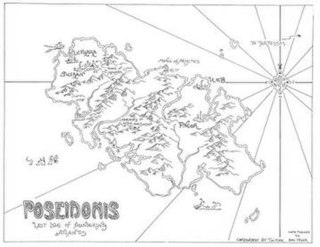
Poseidonis is the fictional last remnant of the lost continent of Atlantis, mentioned by Algernon Blackwood in his short story "Sand" in his collection Four Weird Tales and also detailed in a series of short stories by Clark Ashton Smith. Smith based Poseidonis on Theosophical scriptures about Atlantis, and his concept of "the last isle of foundering Atlantis" is echoed by the isle of Númenor in J. R. R. Tolkien's legendarium.

Skjöldr was among the first legendary Danish kings. He is mentioned in the Prose Edda, in Ynglinga saga, in Chronicon Lethrense, in Sven Aggesen's history, in Arngrímur Jónsson's Latin abstract of the lost Skjöldunga saga and in Saxo Grammaticus' Gesta Danorum. He also appears in the Old English poem Beowulf. The various accounts have little in common.
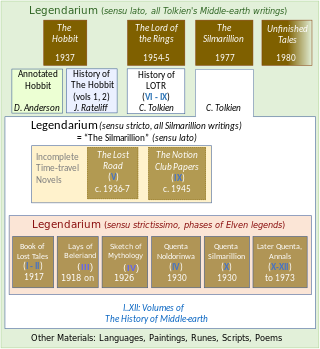
Tolkien's legendarium is the body of J. R. R. Tolkien's mythopoeic writing, unpublished in his lifetime, that forms the background to his The Lord of the Rings, and which his son Christopher summarized in his compilation of The Silmarillion and documented in his 12-volume series The History of Middle-earth. The legendarium's origins reach back to 1914, when Tolkien began writing poems and story sketches, drawing maps, and inventing languages and names as a private project to create a mythology for England. The earliest story, "The Voyage of Earendel, the Evening Star", is from 1914; he revised and rewrote the legendarium stories for most of his adult life.
The cosmology of J. R. R. Tolkien's legendarium combines aspects of Christian theology and metaphysics with pre-modern cosmological concepts in the flat Earth paradigm, along with the modern spherical Earth view of the Solar System.

Venusberg is a motif of European folklore rendered in various legends and epics since the Late Middle Ages. It is a variant of the folktale topos of "a mortal man seduced by the fairy queen visits the otherworld". In German folklore of the 16th century, the narrative becomes associated with the minnesinger Tannhäuser who becomes obsessed with worshipping the goddess Venus.

Middle-earth is the setting of much of the English writer J. R. R. Tolkien's fantasy. The term is equivalent to the Miðgarðr of Norse mythology and Middangeard in Old English works, including Beowulf. Middle-earth is the oecumene in Tolkien's imagined mythological past. Tolkien's most widely read works, The Hobbit and The Lord of the Rings, are set entirely in Middle-earth. "Middle-earth" has also become a short-hand term for Tolkien's legendarium, his large body of fantasy writings, and for the entirety of his fictional world.
"Fastitocalon" is a medieval-style poem by J. R. R. Tolkien about a gigantic sea turtle. The setting is explicitly Middle-earth. The poem is included in The Adventures of Tom Bombadil.

The Story of Sigurd the Volsung and the Fall of the Niblungs (1876) is an epic poem of over 10,000 lines by William Morris that tells the tragic story, drawn from the Volsunga Saga and the Elder Edda, of the Norse hero Sigmund, his son Sigurd and Sigurd's wife Gudrun. It sprang from a fascination with the Volsung legend that extended back twenty years to the author's youth, and had already resulted in several other literary and scholarly treatments of the story. It was Morris's own favorite of his poems, and was enthusiastically praised both by contemporary critics and by such figures as T. E. Lawrence and George Bernard Shaw. In recent years it has been rated very highly by many William Morris scholars, but has never succeeded in finding a wide readership on account of its great length and archaic diction. It has been seen as an influence on such fantasy writers as Andrew Lang. The Story of Sigurd is available in modern reprints, both in its original form and in a cut-down version, but there is no critical edition.
J. R. R. Tolkien used frame stories throughout his Middle-earth writings, especially his legendarium, to make the works resemble a genuine mythology written and edited by many hands over a long period of time. He described in detail how his fictional characters wrote their books and transmitted them to others, and showed how later in-universe editors annotated the material.

The Old Straight Road, the Straight Road, the Lost Road, or the Lost Straight Road, is J. R. R. Tolkien's conception, in his fantasy world of Arda, of the route that his Elves are able to follow to reach the earthly paradise of Valinor, realm of the godlike Valar. The tale is mentioned in The Silmarillion and in The Lord of the Rings, and documented in The Lost Road and Other Writings. The Elves are immortal, but may grow weary of the world, and then sail across the Great Sea to reach Valinor. The men of Númenor are persuaded by Sauron, servant of the first Dark Lord Melkor, to attack Valinor to get the immortality they feel should be theirs. The Valar ask for help from the creator, Eru Ilúvatar. He destroys Númenor and its army, in the process reshaping Arda into a sphere, and separating it and its continent of Middle-earth from Valinor so that men can no longer reach it. But the Elves can still set sail from the shores of Middle-earth in ships, bound for Valinor: they sail into the Uttermost West, following the Old Straight Road.














